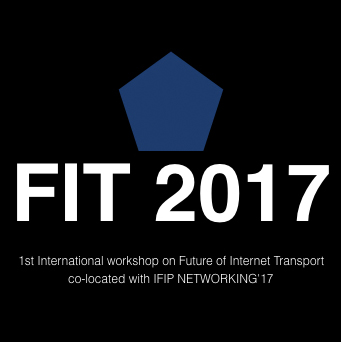Technical Program
Panel Discussion
Proceedings
Workshop on Future of Internet Transport (FIT 2017)
There is an emerging demand by applications for new transport services beyond what TCP or UDP can offer. These new demands stem from a need for more flexible transport services, including the need to cater for very low latency traffic, the ability to more efficiently exploit new access technologies (e.g., cellular networks, WiFi, LEO satellites and possibly combinations thereof) and the need to provide end-to-end functionality in the presence of misbehaving middleboxes.
However, the Internet transport layer has become ossified, making it difficult to introduce new protocols and transport services. There is a "deployment vicious circle", where on the one hand, middlebox operators and vendors have been hesitant to let through traffic from rarely used protocols, and, on the other hand, application developers have been hesitant to employ new transport protocols knowing that they are likely to be blocked by middleboxes.
Several new solutions have been proposed over the recent years to address the need for new services, including SCTP, Google's QUIC, MPTCP and Adobe's RTMFP. Meanwhile the ossification problem has been approached from different angles in order to provide a viable path to facilitate the natural evolution of the Internet transport layer. For instance UDP encapsulation techniques for transport protocols have been employed (used by QUIC, RTMFP, Minion and PLUS) and transport/network "happy eyeballing" mechanisms are considered for providing middlebox traversal (used by Apple and discussed in the IETF). Another instance is the IETF's intention to specify a new transport API that is protocol- and platform-independent and allows the transport stack to independently evolve without requiring application developers to participate in this process, hence breaking the deployment vicious circle.
The FIT 2017 workshop will present and discuss research and development within this problem space. The workshop aims to address these questions: (1) what approach is the most appropriate one for the long-term evolution of Internet transports? (2) how can these different approaches be compatible and interoperable with each other as they are being deployed across the Internet and access links with widely varying characteristics? and (3) which of these approaches provides the best transition path from the current Internet transport architecture to the future transport?
Topics of interest include, but are not limited to:
● Solutions to the Internet transport layer ossification
● Scalable, deployable, extensible and flexible transport protocol and service solutions
● New transport protocols, services and requirements (including extensions to, or evaluations of, e.g., QUIC, SCTP, RTMFP, MPTCP)
● Middlebox traversal techniques and signalling (e.g., ICE, STUN, TURN, UDP encapsulation)
● Service oriented and expressive transport APIs and Berkeley socket API extensions
● Multipath transports and intelligent multipath resource utilization and scheduling
● Transport protocols for data-center networks with implications on the Internet (e.g., DCTCP)
● Transport protocol interactions with the network, e.g., to better interoperate with WiFi, cellular or satellite networks
● TCP/UDP/IP extensions for richer transport services
● Opportunistic use of QoS mechanisms (e.g., DSCP usage in WebRTC)
● Less-than-best-effort transport protocols and services
● Transport selection mechanisms (e.g., happy-eyeballing)
● Transport layer security
● Web-based transport services (e.g., HTTP/2)
● Novel congestion control schemes (e.g. coupled, delay-based, ECN based, Bottleneck Bandwidth and RTT based (e.g., BBR), model based)
● Design and performance of transport protocols in userland
● Transport protocols and solutions for multimedia traffic (e.g., WebRTC, MPRTP, RTMFP)
● Standardization of transport protocols and services
● Novel Internet transport architectures
Paper format and submission instructions
Submitted papers should be unpublished work and they should not be under review by any other conference or journal. They must be no more than 6 pages (IEEE two-column format, 10pt) in total including references and figures. Papers will be reviewed single-blind. Please follow the submission link on https://edas.info/N23329 for submitting your paper.
Guidelines on paper submission and formatting are available here. Note that FIT 2017 adopts the IFIP TC Open Access policy. The IFIP DL is Open Access. IFIP holds papers copyright, and releases it freely to authors for any use.
Accepted papers will appear in the symposium proceedings published by IFIP and submitted to IEEE Xplore Digital Library. At least one author of each accepted paper is required to register and present the work in the workshop.
For questions related to the paper submission and other matters please contact naeemk [at] ifi [dot] uio [dot] no.
Important Dates
Paper submission deadline: March 8, 2017 March 15, 2017 23:59 AoE (Extended deadline)
Paper acceptance notification: April 19, 2017
Camera ready: April 27, 2017
Workshop: June 12, 2017
Organizers
Workshop co-chairs
Naeem Khademi (Department of Informatics, University of Oslo, Norway) 

Stein Gjessing (Department of Informatics, University of Oslo, Norway) 
Åke Arvidsson (Ericsson, Sweden) 
Technical Program Committee
Özgü Alay (Simula Research Laboratory, Norway)
Grenville Armitage (Swinburne University of Technology, Australia)
Anna Brunstrom (Karlstad University, Sweden)
David Black (Dell EMC, USA)
Mohamed Boucadair (Orange, France)
Zdravko Bozakov (Dell EMC, Ireland)
Bob Briscoe (Simula Research Laboratory, Norway)
Jon Crowcroft (Cambridge University, United Kingdom)
Spencer Dawkins (Huawei Technologies, USA)
Koen De Schepper (Nokia, Belgium)
Lars Eggert (NetApp, Germany)
Yehia Elkhatib (Lancaster University, United Kingdom)
Gorry Fairhurst (University of Aberdeen, United Kingdom)
Simone Ferlin (IBM Security, Norway)
Karl-Johan Grinnemo (Karlstad University, Sweden)
David Hayes (Simula Research Laboratory, Norway)
Safiqul Islam (University of Oslo, Norway)
Ingemar Johansson (Ericsson, Sweden)
Mirja Kuehlewind (ETH Zurich, Switzerland)
Nicolas Kuhn (CNES, France)
Renato Lo Cigno (University of Trento, Italy)
Marie-Jose Montpetit (TriangleVideo, USA)
Jörg Ott (Technische Universität München, Germany)
Rong Pan (Cisco, USA)
Tommy Pauly (Apple, USA)
Colin Perkins (University of Glasgow, United Kingdom)
David Ros (Simula Research Laboratory, Norway)
Michael Scharf (Nokia, Germany)
Brian Trammell (ETH Zurich, Switzerland)
Michael Tüxen (Münster University of Applied Sciences, Germany)
Michael Welzl (Department of Informatics, University of Oslo, Norway)





